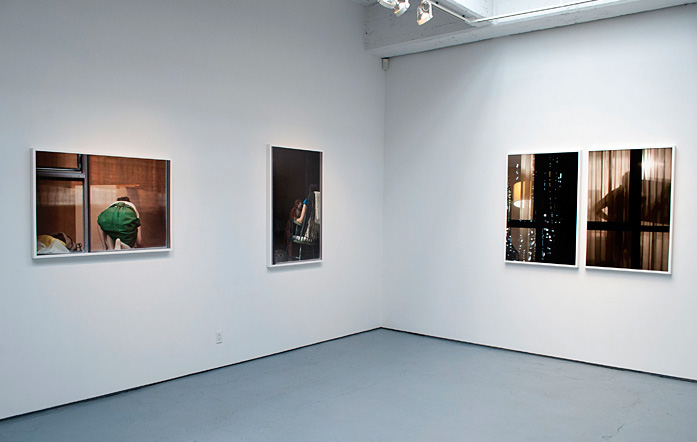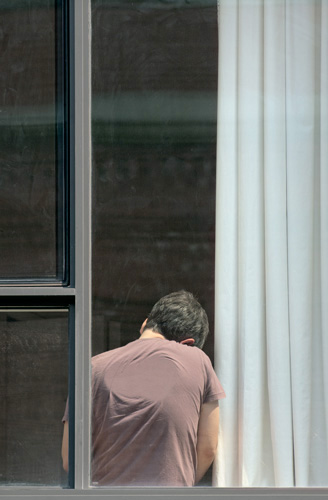 Arne Svenson's show "The Neighbors" hanging at Julie Saul Gallery in New York City. The show was up from May 9 to June 29.
Arne Svenson's show "The Neighbors" hanging at Julie Saul Gallery in New York City. The show was up from May 9 to June 29.
Photo courtesy Julie Saul Gallery.
Do you remember Arne Svenson? We wrote about him a while back, last May to be exact. He's the fellow who engaged in a long-term art project shooting pictures through the open windows of the apartment building on the other side of the street from where he lives in New York City. Sort of a glorified, gussied-up peeping-Tom kind of thing. Some of his neighbors were displeased, as they discovered large prints of themselves taken surreptitiously through their windows being put on view at a prestigious city gallery.
One couple sued.
Well, the court has now ruled—in the artist's favor. Judge Eileen Rakower of the New York Supreme Court limited her decision to the "circumstances presented here," but wrote that the artist's First Amendment protections outweigh the subjects' expectations for privacy.
Note that issues like this are never not going to be thorny, and, as Ctein often reminds us, such issues often come down to case-by-case adjudication.
 Arne Svenson, "The Neighbors" #16
Arne Svenson, "The Neighbors" #16
Personally, I like the pictures, small JPEG renderings of which can be seen on Arne's website. But I sympathize more with the neighbors (the body of work is called "The Neighbors"). I find I identify with them more than I do with the photographer, and I know that I would definitely not want someone snapping pictures of me in my home through my open window.
But the judge's ruling seems sensible. Through the scaffolding of due process and legalese, the ruling seems to say, in effect, "In this case, it wasn't that bad."
Mike
(Thanks to several readers)
Original contents copyright 2013 by Michael C. Johnston and/or the bylined author. All Rights Reserved. Links in this post may be to our affiliates; sales through affiliate links may benefit this site.
(To see all the comments, click on the "Comments" link below.)
Featured Comments from:
Carsten S: "I am more concerned about the watching that he had to do to take the pictures than about the publication of that particular selection of photos."
David A. Goldfarb: "There are relatively few buildings like the Zinc Building in New York—seven stories with floor-to-ceiling windows and 21 apartments in a bustling Tribeca location, where an 880 sq. ft., 1 bdrm, 1.5 bath apartment sold for $1.375 million just this past April. If one wanted not to be on display, it would be easy enough not to live there."
Mike replies: I know this is off topic, but that's one of the reasons I like Waukesha: around the corner from me, there is a big, beautiful stone house with 5,000 square feet including an indoor gym, four one-car garages and an oversized garage for an RV, on a beautifully kept 2.5-acre lot with mature trees and a broad lawn. Hammer price: $319,000. Sold just a few months ago. Of course, it's not New York; but then, some people would prefer quiet, safe, friendly li'l ol' Waukesha. The realtor: "It takes a special kind of buyer. The taxes are very high." Taxes: $9k annually.
Back on topic: Does the size of your windows really change the issue? That sounds suspiciously like the old saw about a woman asking to be raped because of the provocative way she dresses. A central tenet of moral behavior is that you follow the principle rather than allowing yourself to be influenced by temptation or opportunism, no?
Of course, the courts have ruled, so we're only talking about ethics here, not legality.
Herman Krieger: "It looked like a window of opportunity."
Bill Poole: "Judging from the images on his site, these are beautifully composed photographs—not of the building residents, but incorporating fragments of their figures into the compositions. (The photographer seems to have gone out of his way to not include recognizable faces.) To me, the result is strangely moving: intimate without being personal or revealing."
Alan Fairley: "As an attorney, I was intrigued by the legal issues in the case. I poked around a bit and found that what Svenson did would almost certainly be actionable in jurisdictions that have a common-law right of privacy, as defined in the Restatement of the law of Torts. However, New York State does not recognize that common law right of privacy, which hamstrung the neighbor's ability to plead a viable claim against Svenson. Instead, they had to sue for 'unauthorized use of likeness for commercial purposes' which, not only in New York but virtually every jurisdiction, recognizes an exception for works of art. Thus, the lawsuit was doomed from the start.
"Personally, I find what Svenson did to be reprehensible, but on the other hand, I find the photographs luminously beautiful. No one ever said art was simple."


